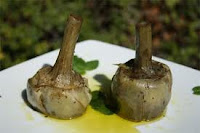Few
vegetables say spring like the artichoke. For me, in Rome, it was always the ultimate sign of la primavera, especially where I lived in the Jewish ghetto, which is known for its numerous restaurants specializing in the deep-fried "Jewish style" artichokes in-season. In the U.S. ,
California Monterey County
From
There to Here: A Brief History of the Thistle
Cynara cardunculus, the globe
artichoke, is thought to
have originated in Northern Africa. Its name comes from the Arabic al-kharshuf or ardi-shoky, meaning
“ground-thorny,” which became carciofo (car-CHO-foe) in Italian. A relative of the cardoon,
the artichoke was cultivated in Sicily
during
the Greek occupation, as early as 500 B.C., and eventually made its way
to
mainland Italy

It’s
the Roman artichoke, the carciofo
romanesco, the Cynara scolymus: a gorgeous, deep purple-and-green
globe. Synonymous with the
celebrated Roman
Spring Rome,
The two
most common local artichoke preparations are alla romana –
Roman-style, slow braised in oil and wine with wild
Roman mint and pecorino cheese, and alla
giudea – Jewish-style, deep-fried twice so the crispy outer petals
open up
but the heart remains tender within. Unlike botanically similar varieties found
elsewhere, the romanesco artichoke is
eaten young, before it gets woody. This allows a greater portion of the
flower
to be edible, though local cooks generally pare down the leaves quite a
bit.
Romans tend to go straight for the tender heart.
Cooking
with Carciofi
Romans
believe artichokes reduce cholesterol, cleanse the liver…and are an
aphrodisiac
to boot. Whatever their benefits may be, nutritional or otherwise,
artichokes
are labor-intensive but well worth the work. A trip to
any Roman market in the spring months will reveal numerous carciofare,
or artichoke trimmers, in quick action with gloved
hands, a sharp knife, and a container of water with cut lemons floating
in it:
the acidulated water keeps the chlorophyll oxidation to a minimum, so
the
artichokes remain green and beautiful. Look for artichokes that are
heavy for
their size, with tightly-packed leaves.
A trip to
any Roman market in the spring months will reveal numerous carciofare,
or artichoke trimmers, in quick action with gloved
hands, a sharp knife, and a container of water with cut lemons floating
in it:
the acidulated water keeps the chlorophyll oxidation to a minimum, so
the
artichokes remain green and beautiful. Look for artichokes that are
heavy for
their size, with tightly-packed leaves.
CARCIOFI
ALLA ROMANA
2 lemons
2 cloves garlic, minced
4 TBS. Chopped fresh flat leaf parsley
4 TBS. Chopped fresh mint or mentuccia
½ cup Pecorino Romano cheese, grated
1 cup dry white wine
2 TBS. Minced olive oil-packed anchovy fillets
(optional)
salt & pepper to taste
extra-virgin olive oil, as needed (about 1-2 cups)
-Fill a large bowl with water and squeeze the juice of
one of the lemons
into it.
-Trim artichoke stems, cut the top of the artichoke
bulb off, and peel
the outer leaves of the artichoke.
-Carefully scoop out the choke with a melon baller or
paring knife.
-As each artichoke is trimmed, put it into the
acidulated water.
-In a small bowl, combine the garlic, parsley, mint,
bread crumbs, and
anchovies, if using. Season with salt & pepper.
-Pat dry the artichokes, stuff the stuffing mixture
into the cavity left
by the choke and between the leaves. Close leaves over filling.
- Place artichokes stem-up in a baking dish and add 1
part olive oil to
1 part white wine to 2 parts water, to almost cover artichoke bulb.
- Cover and cook until tender when tested with a
toothpick/skewer, about
45 minutes to an hour (either in oven or on the stovetop).
- Can be served warm or eaten at room temperature,
kept in the braising
liquid. Serve with lemon wedges.







omigod i miss rome so much right now.
ReplyDelete